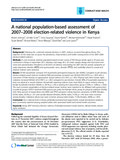A national population-based assessment of 2007–2008 election-related violence in Kenya

View/
Date
2014-01-18Author
Johnson, Kirsten
Scott, Jennifer
Sasyniuk, Treny
Ndetei, David
Kisielewski, Michael
Rouhani, Shada
Bartels, Susan
Mutiso, Victoria
Mbwayo, Anne
Rae, David
Lawry, Lynn
Type
Journal ArticleMetadata
Show full item recordAbstract
Abstract
Background
Following the contested national elections in 2007, violence occurred throughout Kenya. The objective of this study was to assess the prevalence, characteristics, and health consequences of the 2007–2008 election-related violence.
Methods
A cross-sectional, national, population-based cluster survey of 956 Kenyan adults aged ≥ 18 years was conducted in Kenya in September 2011 utilizing a two-stage 90 x 10 cluster sample design and structured interviews and questionnaires. Prevalence of all forms of violence surrounding the 2007 election period, symptoms of major depressive disorder (MDD) and posttraumatic stress disorder (PTSD), and morbidity related to sexual and physical violence were assessed.
Results
Of 956 households surveyed, 916 households participated (response rate 95.8%). Compared to pre-election, election-related sexual violence incidents/1000 persons/year increased over 60-fold (39.1-2370.1; p < .001) with a concurrent 37-fold increase in opportunistic sexual violence (5.2-183.1; p < .001). Physical and other human rights violations increased 80-fold (25.0-1987.1; p < .001) compared to pre-election. Overall, 50% of households reported at least one physical or sexual violation. Households reporting violence were more likely to report violence among female household members (66.6% vs. 58.1%; p = .04) or among the Luhya ethnic group (17.0% vs. 13.8%; p = 0.03). The most common perpetrators of election-related sexual violence were reported to be affiliated with government or political groups (1670.5 incidents/1000 persons per year); the Kalenjin ethnic group for physical violations (54.6%). Over thirty percent of respondents met MDD and PTSD symptom criteria; however, symptoms of MDD (females, 63.3%; males, 36.7%; p = .01) and suicidal ideation (females, 68.5%; males, 31.5%; p = .04) were more common among females. Substance abuse was more common among males (males, 71.2%; females, 28.8%; p < .001).
Conclusion
On a national level in Kenya, politically-motivated and opportunistic sexual and physical violations were commonly reported among sampled adults with associated health and mental health outcomes.
